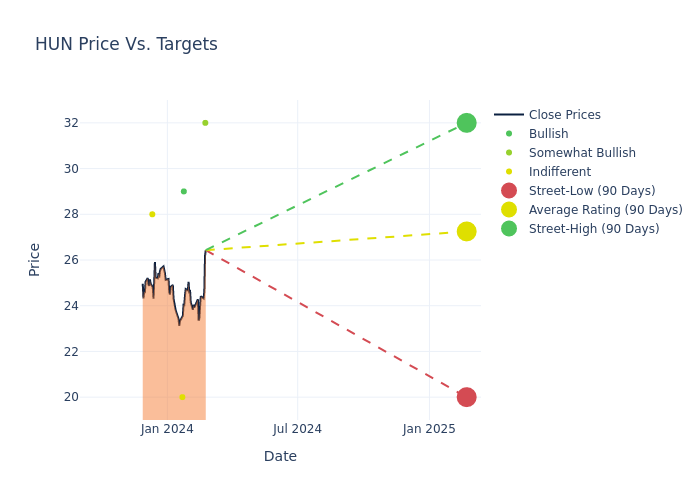During the last three months, 4 analysts shared their evaluations of Huntsman HUN, revealing diverse outlooks from bullish to bearish.
The following table provides a quick overview of their recent ratings, highlighting the changing sentiments over the past 30 days and comparing them to the preceding months.
| Bullish | Somewhat Bullish | Indifferent | Somewhat Bearish | Bearish | |
|---|---|---|---|---|---|
| Total Ratings | 1 | 1 | 2 | 0 | 0 |
| Last 30D | 0 | 1 | 0 | 0 | 0 |
| 1M Ago | 1 | 0 | 0 | 0 | 0 |
| 2M Ago | 0 | 0 | 1 | 0 | 0 |
| 3M Ago | 0 | 0 | 1 | 0 | 0 |
Providing deeper insights, analysts have established 12-month price targets, indicating an average target of $27.25, along with a high estimate of $32.00 and a low estimate of $20.00. Surpassing the previous average price target of $25.33, the current average has increased by 7.58%.

Diving into Analyst Ratings: An In-Depth Exploration
An in-depth analysis of recent analyst actions unveils how financial experts perceive Huntsman. The following summary outlines key analysts, their recent evaluations, and adjustments to ratings and price targets.
| Analyst | Analyst Firm | Action Taken | Rating | Current Price Target | Prior Price Target |
|---|---|---|---|---|---|
| Michael Sison | Wells Fargo | Raises | Overweight | $32.00 | $25.00 |
| Vincent Anderson | Stifel | Lowers | Buy | $29.00 | $30.00 |
| Arun Viswanathan | RBC Capital | Lowers | Sector Perform | $20.00 | $21.00 |
| Angel Castillo | Morgan Stanley | Announces | Equal-Weight | $28.00 | - |
Key Insights:
- Action Taken: Analysts respond to changes in market conditions and company performance, frequently updating their recommendations. Whether they 'Maintain', 'Raise' or 'Lower' their stance, it reflects their reaction to recent developments related to Huntsman. This information offers a snapshot of how analysts perceive the current state of the company.
- Rating: Analyzing trends, analysts offer qualitative evaluations, ranging from 'Outperform' to 'Underperform'. These ratings convey expectations for the relative performance of Huntsman compared to the broader market.
- Price Targets: Analysts explore the dynamics of price targets, providing estimates for the future value of Huntsman's stock. This examination reveals shifts in analysts' expectations over time.
Navigating through these analyst evaluations alongside other financial indicators can contribute to a holistic understanding of Huntsman's market standing. Stay informed and make data-driven decisions with our Ratings Table.
Stay up to date on Huntsman analyst ratings.
Discovering Huntsman: A Closer Look
Huntsman Corp is a us-based manufacturer of differentiated organic chemical products. Its product portfolio comprises Methyl diphenyl diisocyanate (MDI), Amines, Maleic anhydride, Epoxy-based polymer formulations. The company's products are used in adhesives, aerospace, automotive, construction products, among others. Its operating segments are Polyurethanes, Performance Products and Advanced Materials. It derives most of its revenue from the Polyurethanes segment which includes MDI, polyols, TPU (thermoplastic polyurethane), and other polyurethane-related products. Its geographical segments are the United States & Canada, Europe, Asia- Pacific, and the Rest of the world.
Huntsman's Financial Performance
Market Capitalization: Indicating a reduced size compared to industry averages, the company's market capitalization poses unique challenges.
Revenue Growth: Huntsman's revenue growth over a period of 3 months has faced challenges. As of 31 December, 2023, the company experienced a revenue decline of approximately -6.84%. This indicates a decrease in the company's top-line earnings. As compared to its peers, the revenue growth lags behind its industry peers. The company achieved a growth rate lower than the average among peers in Materials sector.
Net Margin: Huntsman's net margin excels beyond industry benchmarks, reaching -5.06%. This signifies efficient cost management and strong financial health.
Return on Equity (ROE): Huntsman's ROE is below industry standards, pointing towards difficulties in efficiently utilizing equity capital. With an ROE of -2.13%, the company may encounter challenges in delivering satisfactory returns for shareholders.
Return on Assets (ROA): Huntsman's ROA falls below industry averages, indicating challenges in efficiently utilizing assets. With an ROA of -0.97%, the company may face hurdles in generating optimal returns from its assets.
Debt Management: Huntsman's debt-to-equity ratio is below the industry average at 0.52, reflecting a lower dependency on debt financing and a more conservative financial approach.
How Are Analyst Ratings Determined?
Benzinga tracks 150 analyst firms and reports on their stock expectations. Analysts typically arrive at their conclusions by predicting how much money a company will make in the future, usually the upcoming five years, and how risky or predictable that company's revenue streams are.
Analysts attend company conference calls and meetings, research company financial statements, and communicate with insiders to publish their ratings on stocks. Analysts typically rate each stock once per quarter or whenever the company has a major update.
Beyond their standard evaluations, some analysts contribute predictions for metrics like growth estimates, earnings, and revenue, furnishing investors with additional guidance. Users of analyst ratings should be mindful that this specialized advice is shaped by human perspectives and may be subject to variability.
This article was generated by Benzinga's automated content engine and reviewed by an editor.
Edge Rankings
Price Trend
© 2025 Benzinga.com. Benzinga does not provide investment advice. All rights reserved.
date | ticker | name | Price Target | Upside/Downside | Recommendation | Firm |
|---|
Trade confidently with insights and alerts from analyst ratings, free reports and breaking news that affects the stocks you care about.